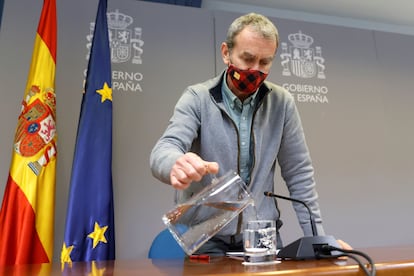Spain reports 9,568 new coronavirus cases, adds 345 deaths to official toll
The 14-day cumulative number of infections per 100,000 inhabitants has fallen to 206, but authorities have repeated their warning against relaxing restrictions too far


The epidemiological curve in Spain has been on a downward trend for a month, with the number of new coronavirus cases continuing to fall. According to the latest Health Ministry report, released on Thursday evening, the 14-day cumulative number of cases per 100,000 inhabitants has now fallen to 206. Spain reached the peak of the third wave of the pandemic on January 26, when it reported a record-high number of new infections. This led the regions – which are responsible for managing the response to the pandemic as well as the Covid-19 vaccination drive – to introduce tough restrictions on social gatherings and mobility. One month on, the Health Ministry reported 9,568 new coronavirus cases on Thursday and added 345 deaths to the official toll. Although the curve of transmissions is on a downward trend, health authorities warned that Spain is still in a high-risk situation. “We cannot relax [restrictions] more than necessary,” said Fernando Simón, the director of the Health Ministry’s Coordination Center for Health Alerts (CCAES), at a press conference to present the latest data on Thursday.
Simón explained that although the incidence rate is falling across Spain, it is doing so at different speeds. In 15 of Spain’s 19 territories (17 regions and the North African exclave cities of Ceuta and Melilla), the 14-day cumulative number of cases per 100,000 inhabitants has fallen below 250 – the threshold considered by the Health Ministry to indicate a situation of extreme risk. And in two regions, it is even below 100: Extremadura (77) and the Balearic Islands (97). But the situation is very uneven and there are some territories, such as Melilla (431) and Madrid (321), where transmission rates are much higher than the national average.
Spain is progressing very well, but the fall is not homogenous. There are regions where the drop is sharp and there are others where the drop is more gradualFernando Simón, director of the Health Ministry’s Coordination Center for Health Alerts
However, the overall trend is positive in almost all of Spain’s regions. Only Catalonia reported a rise in its incidence rate, with the 14-day cumulative number of cases per 100,000 inhabitants at 219, up from 217 on Wednesday. This data point reflects the threat of a new spike in cases that has been hanging over the region and that forced the Catalan government to put the brakes on its plans to ease coronavirus restrictions. According to data from the regional government, the speed of the propagation of the virus, known as the R number – i.e. how many people a positive case infects on average – has been above one for the past two days. This is the limit that the health authorities have established to consider the pandemic under control.
“Spain is progressing very well, but the fall is not homogenous. There are regions where the drop is sharp and there are others where the drop is more gradual. This has to make us reflect on measures [to control the spread of the coronavirus],” said Simón. “We don’t believe we are in a good situation.”
The main concern continues to be the pressure on hospitals. While admissions are falling, intensive care units (ICUs) are still under great strain. According to the latest report, nearly 30% of ICU beds are occupied by Covid-19 patients (3,123). “The occupancy rate we are seeing now is still higher than what it was during the peak of the second wave,” said Simón. This pressure means that the country’s hospitals may be overwhelmed if there is a new spike in infections. “The healthcare system still does not have the capacity to react to an increase in cases. We have to be aware that the goal is to control transmission as much as possible,” explained Simón.
Since the beginning of the pandemic, a total of 68,813 people have died after testing positive for the coronavirus, according to Thursday’s report. This figure, however, does not include the thousands of victims who were not diagnosed during the first wave, meaning they were not included in the official count. According to the Health Ministry, there have been 875 Covid-19-related fatalities in the last seven days.
Women’s Day march
With Women’s Day approaching and the Easter holidays less than a month away, Simón called on the public to exercise caution, as these events are likely to lead to an increase in travel and crowds. The central government’s delegate in Madrid, José Manuel Franco, announced on Wednesday that all events for Women’s Day on March 8 where more than 500 attendees are expected will be suspended in accordance with the recommendations from the regional health department. Simón said the degree to which such a gathering could increase the spread of the coronavirus depended on “the relationship between these 500 people.” He explained: “If they maintain safe distances and wear face masks, there will be fewer risks, but not none. Spain always has to be especially careful not to specify figures, but rather establish the quality of the relationship [between members of a social gathering].
“The risks are associated with the way in which people relate to one another,” he continued. “And the way changes according to the reason for the gathering. Carrying a saint during an Easter parade is not the same as being at a protest with 500 people where people can spread out and maintain distances. If the right measures are maintained, the risks are reduced. That said, it is better to avoid large crowds of people.”
Health Minister Carolina Darias also took a stand on Tuesday against Women’s Day events. “To be coherent with the call for responsibility that I have made, given that we are still in a situation of extreme risk, there is no place [for such events].”
English version by Melissa Kitson.
Tu suscripción se está usando en otro dispositivo
¿Quieres añadir otro usuario a tu suscripción?
Si continúas leyendo en este dispositivo, no se podrá leer en el otro.
FlechaTu suscripción se está usando en otro dispositivo y solo puedes acceder a EL PAÍS desde un dispositivo a la vez.
Si quieres compartir tu cuenta, cambia tu suscripción a la modalidad Premium, así podrás añadir otro usuario. Cada uno accederá con su propia cuenta de email, lo que os permitirá personalizar vuestra experiencia en EL PAÍS.
¿Tienes una suscripción de empresa? Accede aquí para contratar más cuentas.
En el caso de no saber quién está usando tu cuenta, te recomendamos cambiar tu contraseña aquí.
Si decides continuar compartiendo tu cuenta, este mensaje se mostrará en tu dispositivo y en el de la otra persona que está usando tu cuenta de forma indefinida, afectando a tu experiencia de lectura. Puedes consultar aquí los términos y condiciones de la suscripción digital.
More information
Últimas noticias
Aquilino Gonell, former Capitol sergeant: ‘If it hadn’t been for the police, the US would be a dictatorship’
A hybrid building: Soccer pitch, housing, and a shopping mall
Europe urges Trump to respect Greenland following annexation threats
Science seeks keys to human longevity in the genetic mixing of Brazilian supercentenarians
Most viewed
- Alain Aspect, Nobel laureate in physics: ‘Einstein was so smart that he would have had to recognize quantum entanglement’
- Mexico’s missing people crisis casts a shadow over World Cup venue
- Why oil has been at the center of Venezuela-US conflicts for decades
- Alvin Hellerstein, a 92-year-old judge appointed by Bill Clinton, to preside over Maduro’s trial in New York
- Cuba confirms death of 32 of its citizens in the US attack against Venezuela









































